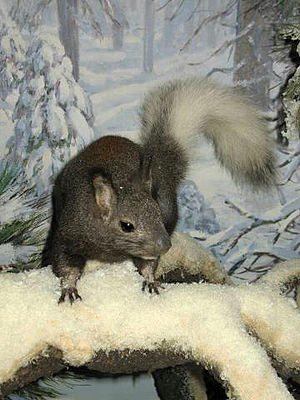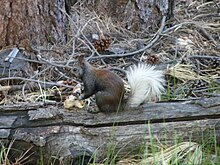Kaib croissants
| Kaib croissants | ||||||||||||
|---|---|---|---|---|---|---|---|---|---|---|---|---|

Kaibabhörnchen ( Sciurus aberti kaibabensis ) |
||||||||||||
| Systematics | ||||||||||||
|
||||||||||||
| Scientific name | ||||||||||||
| Sciurus aberti kaibabensis | ||||||||||||
| Merriam , 1904 |
The kaibab squirrel ( Sciurus aberti kaibabensis ) is a squirrel that is native to the kaibab plateau on the northern edge of the Grand Canyon . It used to be classified as a separate species ( Sciurus kaibabensis ), today it is considered a subspecies of the Aberthörnchen ( Sciurus aberti ).
description
It has a 35 cm long dark gray to black body and a 25 cm long white bushy tail. Of all the subspecies of the Aberthörnchen, the medium-sized squirrel has the shortest tail in relation to its length. It is steel gray and usually has a dorsal reddish brown spot. The belly is black or blackish gray, the tail both underneath and above white and only with a few black hairs. There are tufts on the ears, which in older animals can reach a length of 25 to 50 millimeters. They stand upright in winter and can hardly be seen in summer.
Distribution and way of life
The main population lives in an 800 km² area, in the so-called Kaibab Plateau on the northern edge of the Grand Canyon in the southwest of the USA in Arizona . In order to prevent epidemics and other disasters, it was naturalized in other regions of Arizona. The population of the squirrels depends on the amount of pine cones that make up their main food. It also feeds on acorns, fruits, mushrooms, seeds and bark. The sleeping nests are built in the branches of the trees and the nests are made of branches and pine needles. The boys are born between April and August.
Isolation and exposure
In 1965 the Kaibab National Forest on the plateau was placed under nature protection. Nevertheless, there were always victims by feral dogs and cats. In addition, its strong dependence on the yellow pine population makes it very vulnerable. The Kaibabhörnchen developed millions of years ago from the Aberthörnchen, which is native to the south rim of the Grand Canyon. When the Grand Canyon was formed by erosion, the pine forests were separated and a separate subspecies developed on the canyon's northern rim.
literature
- Richard W. Thorington Jr. , John L. Koprowski, Michael A. Steele: Squirrels of the World. Johns Hopkins University Press, Baltimore MD, 2012, ISBN 978-1-4214-0469-1 , p. 38.
- John Tobias: Abert and Kaibabhörnchen In: Nigel Sitwell (Ed.): Wildlife. Wildlife 76th Yearbook of World Conservation. Südwest-Verlag, Munich 1977, ISBN 3-517-00600-9 , pp. 58-63.
- Dorcas MacClintock : Squirrels of North America , A California of Academy of Sciences Book, Van Nostrand Reinhold Company, New York, 1970, pp. 124-129
- Glover M. Allen : Extinct and vanishing Mammals of the Western Hemisphere. With the Marine species of all the Oceans (= American Committee for International Wild Life Protection. Special Publication. No. 11, ZDB -ID 971409-1 ). American Committee for International Wild Life Protection, New York NY 1942.
- C. Hart Merriam : Two new Squirrels of the Aberti Group. In: Proceedings of the Biological Society of Washington. Vol. 17, 1904, ISSN 0006-324X , pp. 129-130, digitized .
Web links
Individual evidence
- ↑ Thorington et al. 2012, p. 38
